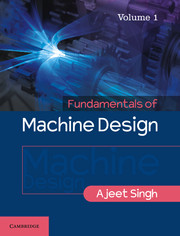1 - Introduction to Machine Design
Published online by Cambridge University Press: 17 July 2025
Summary
Introduction
Machine is a device, which facilitates the working for which it is designed. For example, sewing machine facilitates stitching, automobiles facilitate travelling. Machines could be of many types, as given below, but here the scope is limited to mechanical machines only. A machine, unless specified, is a Mechanical machine. Input to this machine could be mechanical, electric, or any other type of power.
⢠Electric machine, which uses electric energy;
⢠Pneumatic machine, which uses compressed air; and
⢠Hydraulic machine, which uses any fluid like water (turbines) or oil, etc.
A machine comprises of many machine elements, like shafts to accommodate the machine elements like pulleys, gears, etc., to transmit power; bearings to support the shaft; frame to support and keep all the parts in the required position. Machine Design is a subject, which deals with the design of machine elements and other aspects like shape, colour, etc. The design is mainly from the strength point of view. The size is calculated so that under the given conditions of loading, the part will not break or deform beyond accepted allowable limit.
Stages in Design
The design of a machine which is seen today is not the original design. Rather, it is being modified every year. For example, models of cars are changing every year. The design is modified as new materials are developed, which could be stronger than the existing ones. Aesthetic sense of users changes with time, which forces the design to change. Following are the stages in design:
1. Conceptual design When a new machine is designed, the idea is first conceived in the mind as to how a machine will work. This idea is jotted down in the form of a rough sketch of the machine on a paper. A list of all the parts it will have is prepared and then each part is sketched.
2. Design for strength Material is selected for each part and its properties, like tensile strength, shear strength, etc., are noted from a data book. Then, the size of each part is calculated based on its strength and allowable deformation limits.
3. Part and assembly drawings Finished drawings are made for each part. An assembly drawing is also made showing the relative position of each part.
Information
- Type
- Chapter
- Information
- Fundamentals of Machine Design , pp. 1 - 19Publisher: Cambridge University PressPrint publication year: 2017
